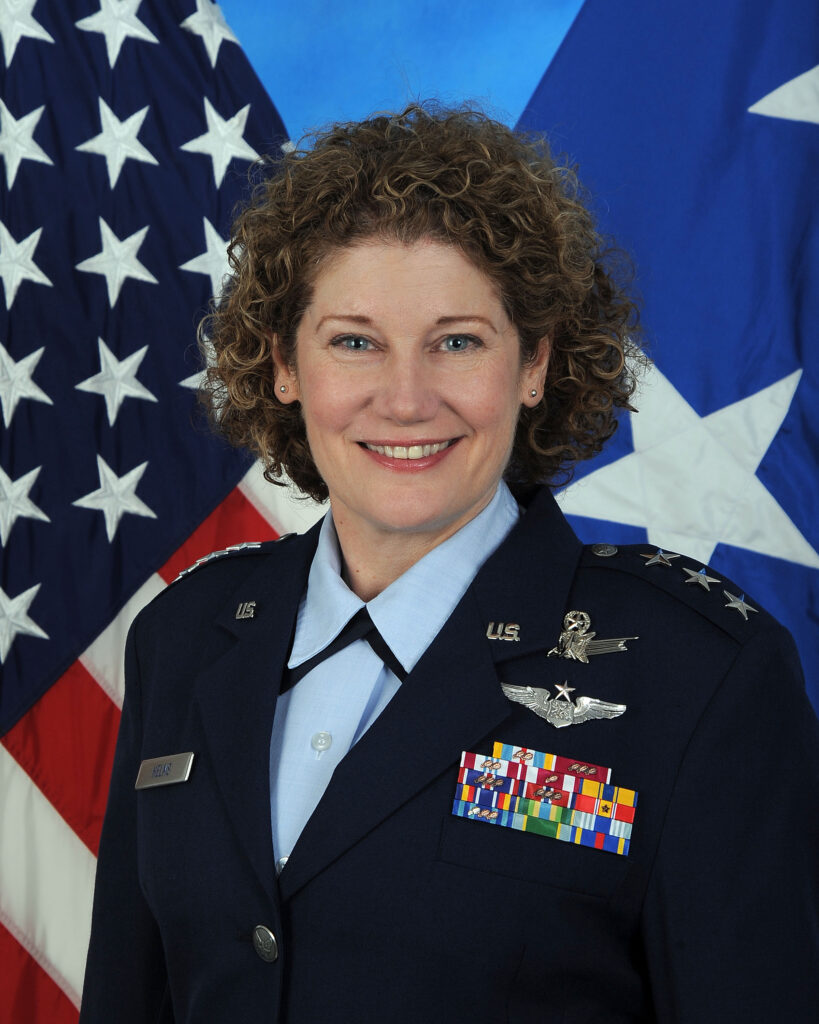Susan J. Helms was born in Charlotte, North Carolina on February 26, 1958, but considers Portland, Oregon, to be her hometown. It was there that she attended Parkrose Senior High School, graduating in 1976. The daughter of an Air Force lieutenant colonel, she attended the U.S. Air Force Academy and in 1980, earned a Bachelor of Science degree in Aeronautical Engineering. After serving in the Air Force as a weapons separation engineer, she was selected to attend graduate school and in 1985 received a Masters degree in Aeronautics/Astronautics from Stanford University. She became an Astronaut in 1991. From 1993 to 2000, Susan Helms flew on shuttle missions STS-54, STS-64, STS-78, and STS-101. In 2001, she served aboard the International Space Station as a member of the Expedition-2 crew, the second group to occupy the station. All of her spaceflights began at Kennedy Space Center (KSC) and all of them landed there as well, except for STS-64, which touched down at Edwards Air Force Base, California.
Helms first entered space on STS-54 Endeavour, from January 13 to 19, 1993. The primary objective of this mission was to deploy a $200-million NASA Tracking and Data Relay Satellite. Her next space mission was STS-64 Discovery, from September 9 to 20, 1994. Helms served as both the flight engineer for orbiter operations and the primary Remote Manipulator System (RMS) operator aboard Space Shuttle. The major objective of the mission was to validate the design and operating characteristics of the Lidar in Space Technology Experiment by gathering data about the Earth’s troposphere and stratosphere. Additional objectives included the deploying and retrieval of SPARTAN-201, a satellite that investigated the physics of the solar corona, and the testing of a new EVA maneuvering device.
On her third mission, STS-78 Columbia, from June 20 to July 7, 1996, Helms was the payload commander and flight engineer on the longest Space Shuttle mission to date. The flight included studies sponsored by ten nations and five space agencies and was the first to combine both a full microgravity studies agenda and a comprehensive life science investigation. The Life and Microgravity Spacelab mission served as a model for future studies on board the International Space Station.
Susan Helms’ next mission, STS-101 Atlantis, (May 19-29, 2000), was dedicated to the delivery and repair of critical hardware for the International Space Station (ISS). As a mission specialist, Helms’ prime responsibilities during this mission were to perform critical repairs to extend the life of the Functional Cargo Block. In addition, she had prime responsibility of the onboard computer network and served as the mission specialist for rendezvous with the ISS.
The ISS Expedition-2 crew, consisting of two Americans (Helms and fellow flight engineer James Voss) and one Russian cosmonaut, Commander Yuri Usachev, was launched on March 8, 2001, onboard STS-102 Discovery and successfully docked with the ISS the next day. The crew installed and conducted tests on the Canadian made Space Station Robotic arm (SSRM), conducted internal and external maintenance tasks in addition to medical and science experiments. During her stay onboard the Space Station, Helms installed the Airlock (brought up on the STS-104 mission) using the SSRM. She and her crewmates also performed a “fly around” of the Russian Soyuz spacecraft and welcomed the visiting Soyuz crew that included the first space tourist, American Dennis Tito.
On March 11, 2001, Helms performed a record 8 hour and 56 minute spacewalk to install hardware to the external body of the laboratory module, the longest EVA in history. Helms spent a total of 163 days aboard the Space Station before returning to Earth with the STS-105 crew aboard Discovery on August 22, 2001. She has logged a total of 211.048 days in space, more than any other woman except Shannon Lucid.
Susan Helms has received many awards. She is a recipient of the Distinguished Superior Service Medal, the Defense Meritorious Service Medal, the Air Force Meritorious Service Medal, the Air Force Commendation Medal, NASA Distinguished Service Medal, NASA Space Flight Medals, and the NASA Outstanding Leadership Medal. She was named a Distinguished Graduate of the USAF Test Pilot School, and recipient of the R.L. Jones Award for Outstanding Flight Test Engineer, Class 88A. In 1990, she received the Aerospace Engineering Test Establishment Commanding Officer’s Commendation, a special award unique to the Canadian Forces. She was named the Air Force Armament Laboratory Junior Engineer of the Year in 1983.
After a stint as the Division Chief of the Space Control Division of the Requirements Directorate of Air Force Space Command in Colorado Springs, Colorado, she served as Vice Commander of the 45th Space Wing at Patrick Air Force Base near Cape Canaveral, Florida. She then served as Deputy Director of Operations for Air Education and Training Command at Randolph Air Force Base near San Antonio, Texas. Susan Helms was promoted to Brigadier General in 2006 as Commander of the 45th Space Wing, Patrick Air Force Base.

